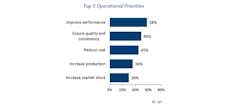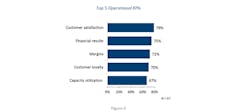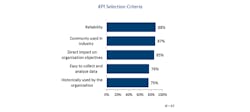Are Manufacturers' KPI Reporting Practices Keeping Up?
As organizations continue to put greater emphasis on facts-based decision making, ensuring relevant measures and timely access to data becomes increasingly important. Often organizations will pinpoint a handful of key performance indicators (KPIs) to gauge the organization’s operational performance. However, picking and aligning the “right” KPIs to the organization’s goals is often easier said than done, much less ensuring data is captured, analyzed, and disseminated in a timely manner.
APQC conducted a survey to garner insights into these challenges. The survey explored the KPIs organizations use to manage operations, their alignment to organizational goals, and the role that measures and reporting make on the decision-making process.
This first of two article uses data from the KPI survey to look at alignment between organizational priorities and the measures organizations use and KPI selection practices.
Picking the Right KPIs
Organizational measures should reflect what’s important to the organization—its value proposition for its customers and its operational needs. To understand how well organizations' KPIs align with “what’s important,” we asked the survey respondents to identify their primary value proposition and to identify their top operational priorities.
How Do Goal and KPIs Align?
Operational concerns are close to the ground. Operational teams, after all, need to deliver value to customers while ensuring short-term profitability and long-term growth. This dynamic tension is evident in manufacturing organizations’ balance between value propositions and operational priorities.
The most prominent value proposition for manufacturing organizations is customer service, with innovation coming in at a distant second.
While, improving performance and ensuring quality and consistency are the top two operational priorities for organizations, cost reductions follows shortly on their heels.
This suggests a healthy mix of objectives: wanting to serve customers better is important, but competitiveness is not far behind.
So how do the KPIs match the organizations’ needs?
Fairly well, it seems. Organizations indicated that customer satisfaction is their primary KPI. This measure matches the primary organizational value proposition. Many organizations balance their goal driven measure with financial and operational KPIs, such as financial results, margins, and capacity utilization--which align with the and the cost and performance priorities. However organizations fall short in matching KPIs with the quality priority.
How Do We Pick Measures?
Best-practice organizations know that choosing the right KPIs is a critical step in generating KPI reports that are meaningful and actionable. A well-balanced set of KPIs provide meaningful insight into an organization’s performance, help identify current challenges and opportunities, and align with the organization’s culture and strategic goals. Generating a well-balanced set of KPIs requires input and expertise across the organization, from key stakeholders to process owners and beyond.
Manufacturing organizations predominantly rely on workshops (78%) with senior-level stakeholders framed by a list of the commonly used KPIs in their industry, related benchmarks and selection criteria. For instance, one organization in the study holds workshops that gather input from department heads, finance directors and the operational excellence team to help drive conversations on KPIs. This approach ensures that a broad range of decision-makers contribute their perspectives and expertise, making it more likely that data from KPIs will be meaningful and actionable for decision-making.
Selection criteria help ensure that the KPIs are well thought out and improve alignment with organizational goals.
Most manufacturing organizations use four typical selection criteria:
- Reliability—can we consistently gather inputs for the measure?
- Impact—does the measure link directly to organizational goals?
- Ease—how easy is it to access and analyze the data?
- Familiarity—is this a measure we have used historically or is it commonly used in our industry?
These criteria help an organization not only manage the KPIs' applicability but also help the organizations understand the availability and accessibility of data. One key criterion that manufacturing organizations’ peers in the services industries are using that they aren’t is the ability to track trends over time. Without this type of context, an organization risks reacting too quickly to a shift in data and instituting unnecessary corrective measures.
For example, one organization includes the ability to track trends over time as part of its selection criteria and embeds that functionality into its end-to-end process, performance dashboard. The features of the dashboard include:
- Current performance—indicates the value for the measure each month. In collecting this information monthly or quarterly, decision makers understand the drivers of performance, both positively and negatively.
- Performance trend—provides comparative context for how the measure has performed over the last four quarters and acts as a quick visual cue for decision makers on whether the process is performing well or needs to be investigated further.
- External benchmarks—compares the organization’s performance against the top quartile (green), median (yellow), and bottom (red) quartile performance of its peer groups. Using the traditional color-coded rating system allows decision makers to quickly identify relative performance and determine if they need drill into to root cause the performance or prioritize an improvement opportunity.
The structure of the dashboard creates context for the decision makers to identity performance issues, asses their priority, and drill in to identify opportunities for improvements.
Conclusion
Overall manufacturing organizations exhibit alignment between their KPIs and organizational objectives at the highest level. The prevalence of financial and operational KPIs like financial results, margins, and capacity utilization is understandable: These measures are directly related to profitability and productivity and are easy to quantify. However, there is still room for organizations to grow in this area. For example, while customer satisfaction and customer loyalty are among the top five KPIs identified by the survey respondents, less common but also useful leading indicators such as quality of ideas, number of ideas, and staff morale do not appear in the top five or even top 10 indicators. These additional measures can serve as great support measures for managing things like innovation and employee engagement—which ultimately help drive customer satisfaction.
When it comes to picking KPIs, most organizations are leveraging best practices and combine stakeholder engagement with criteria used to balance strategic alignment with data availability, quality and access. However, its important to note that KPI selection is not a once and done endeavor. It’s just as important to regularly re-evaluate measures to ensure that they are still relevant and accurate. Organizations need to view performance management as a continuous journey that requires new goals and measures as the organization and its goals mature.
In the next article we will discuss how manufacturing organizations use their KPIs for decision making. More specifically their reporting practices, cycle times and use of automation.
Holly Lyke-Ho-Gland is process and performance principal research lead with APQC, a member-based nonprofit and one of the leading proponents of benchmarking and best practice business research.
About the Author
Holly Lyke-Ho-Gland
Holly Lyke-Ho-Gland is a principal research lead who conducts and publishes APQC research on process management and improvement, quality, project management, measurement, and benchmarking for APQC’s Process and Performance Management research team. Her research supports APQC members and clients across disciplines and centers on helping professionals and project managers solve business problems with strategy, process and measurement.




